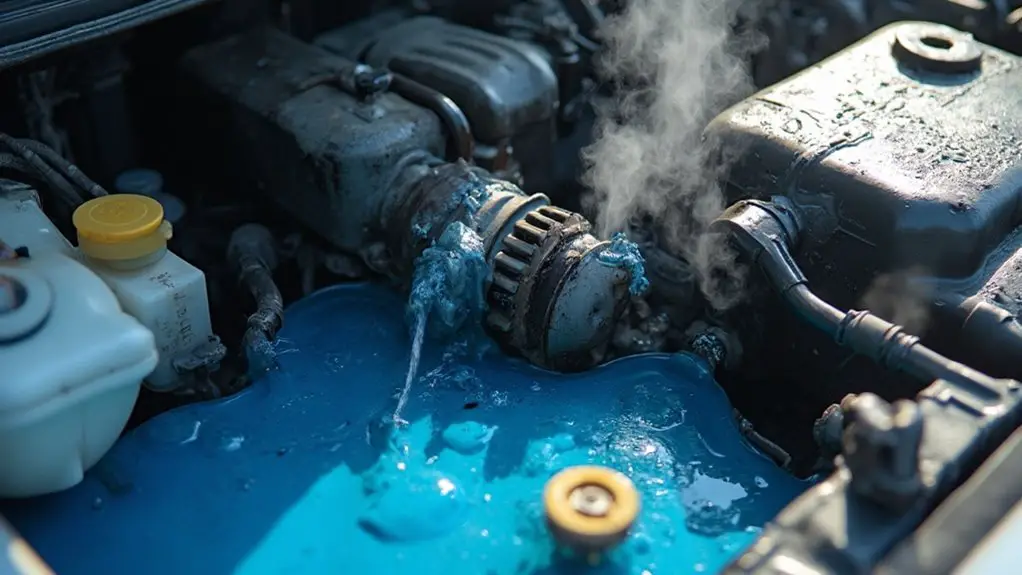Five signs of a bad or blown head gasket include overheating of the cooling system, oil contamination, poor engine performance, external leaks, and white smoke emitted from the exhaust. Overheating often arises from low coolant levels. Oil contamination leads to a milky sludge that jeopardizes engine integrity. Performance issues manifest as rough operation, while external leaks pose safety risks. Finally, white smoke and a sweet odor indicate coolant entering the combustion chamber. More details on these symptoms can provide clearer insights.
Overheating of the Cooling System
Overheating in the cooling system often serves as a critical warning sign of a failing head gasket. As the engine temperature rises, low coolant levels or existing leaks can exacerbate this issue, leading to severe damage.
If coolant enters the combustion chambers, it may result in burning coolant, further elevating engine temperatures. Prolonged overheating can warp the cylinder head and damage the catalytic converter.
Ignoring these signs can jeopardize engine integrity, making timely diagnosis and repair essential to prevent escalating repair costs. Regular monitoring of coolant levels and temperature gauges is crucial for early intervention and protection against serious engine damage.
Oil Contamination
Contamination of oil presents a significant concern for vehicle performance and longevity. When a head gasket fails, coolant can enter the oil system, leading to a milky sludge appearance on the oil filler cap. This contamination risks severe engine damage and may necessitate disassembly for thorough inspection.
Key implications of oil contamination include:
- Engine Bearing Damage: Contaminated oil compromises lubrication, risking wear on engine bearings.
- Oil Flush Requirement: Repair necessitates an oil flush and filter replacement to remove contaminants.
- Potential Engine Inspection: Further inspection may be needed to assess the condition of internal components.
Bad Engine Performance
When a head gasket fails, the repercussions extend beyond oil contamination, affecting overall engine performance. Compression loss occurs as air and fuel escape, leading to symptoms such as rough operation and diminished power. Additionally, coolant may enter the combustion chamber, resulting in misfires and potential engine codes triggering the check engine light. Strange sounds may also emerge, indicating possible exhaust leaks tied to head gasket issues.
| Symptoms | Description |
|---|---|
| Rough Operation | Engine runs unevenly |
| Power Loss | Noticeable decrease in acceleration |
| Misfires | Engine stalls or hesitates |
| Check Engine Light | Illuminates due to misfire codes |
| Strange Noises | Unusual sounds from the engine |
External Leaks
External leaks from a failing head gasket can create significant concerns for vehicle owners.
These leaks typically manifest as noticeable oil or coolant spills under the vehicle, leading to potential operational hazards. Ignoring these issues can result in severe engine damage and costly repairs.
Key considerations include:
- Messy Conditions: Oil and coolant spills create unsafe driving environments.
- Overheating Risks: Low coolant levels can lead to engine overheating and catastrophic failure.
- Fire Hazards: Leaking oil on hot exhaust components poses a serious fire risk.
Addressing external leaks promptly is essential for maintaining vehicle safety and performance.
White Smoke Emitted From the Exhaust
White smoke emitted from the exhaust is often a telltale sign of a head gasket issue. This phenomenon typically occurs when coolant leaks into the engine's combustion chamber, where it is vaporized during the combustion process.
The resulting white smoke indicates that the engine is burning coolant, leading to potential overheating and further engine damage. Drivers may also notice a sweet odor accompanying the smoke, which is characteristic of burning antifreeze.
Ignoring this symptom can exacerbate the problem, risking more serious consequences such as warped cylinder heads and increased repair costs. Immediate attention is advisable to prevent further damage.
Frequently Asked Questions
How Is a Head Gasket Replaced?
The process of replacing a head gasket involves removing the cylinder head, cleaning surfaces, applying new gasket material, and reassembling components. Proper torque specifications and sequence are vital to guarantee a successful installation and prevent future issues.
What Causes a Head Gasket to Fail?
Various factors can cause a head gasket to fail, including overheating, improper installation, engine wear, and coolant contamination. These issues can lead to pressure imbalances, resulting in significant damage to the engine over time.
How Much Does a Head Gasket Replacement Cost?
The cost of head gasket replacement typically ranges from $1,000 to $2,500, depending on vehicle make and model, labor rates, and whether additional repairs are needed. Thorough diagnostics may influence the final expense considerably.
Can I Drive With a Blown Head Gasket?
Driving with a blown head gasket is highly inadvisable. It can lead to severe engine damage, overheating, and costly repairs. Immediate attention is essential to prevent further complications and guarantee vehicle longevity.
What Tools Are Needed for Head Gasket Repair?
To repair a head gasket, one typically requires essential tools such as a socket set, torque wrench, gasket scraper, engine hoist, and a cooling system pressure tester to guarantee a proper and efficient repair process.
